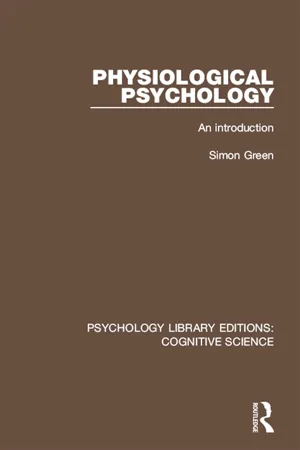Biological Bases of Memory
The biological bases of memory refer to the physical structures and processes in the brain that underlie the encoding, storage, and retrieval of memories. This includes the role of neurotransmitters, synaptic connections, and specific brain regions such as the hippocampus and amygdala. Understanding the biological foundations of memory helps to explain how memories are formed and how they can be affected by brain injuries or diseases.
6 Key excerpts on "Biological Bases of Memory"
- eBook - ePub
Behavioral Neuroscience
An Introduction
- Carl W. Cotman, James L McGaugh(Authors)
- 2014(Publication Date)
- Academic Press(Publisher)
...The memory can be indicated by speaking, dialing, pushing buttons or in other ways, such as writing or simply identifying the sequence of numbers as the correct number. The memory is formed rapidly, is usually transient, but, with rehearsal or repetition, can become long-lasting. This chapter reviews approaches to the neuroBiological Bases of Memory. The chapter discusses the effects of brain lesions on retention and neurobiological correlates of memory. I. Approaches to the NeuroBiological Bases of Memory II. Effects of Brain Lesions on Retention III. Neurobiological Correlates of Memory IV. Neurophysiological Correlates of Learning V. EEG Studies of Learning VI. Unit Studies of Learning VII. Evoked Potentials VIII. Neurochemical Correlates of Training IX. Experimental Modulation of Memory Storage Processes X. Retrograde Amnesia XI. Effects of Direct Electrical Stimulation of the Brain XII. Facilitating Effects of Brain Stimulation XIII. Effects of CNS Stimulants on Memory XIV. Effects of Inhibition of RNA and Protein Synthesis XV. Endogenous Modulators of Memory Storage XVI. Peripheral Catecholamines XVII. Sleep and Memory Modulation XVIII. Brain Pathology and Memory XIX. The Amnesic Syndrome: An Introduction XX. Retrograde Amnesia in Human Patients XXI. Neuropathology XXII. The Psychological Defect in Amnesia XXIII. The Organization of Memory in the Brain XXIV. Summary Key Terms General References References Learning and memory involve a complex set of processes by which experiences alter the nervous system in ways such that the changes endure and effect subsequent experience and behavior. The problem of understanding the neuronal basis of learning and memory is not a simple one of determining the neuronal residue of experience...
- eBook - ePub
Human Memory
Structures and Images
- Mary B. Howes(Author)
- 2006(Publication Date)
- SAGE Publications, Inc(Publisher)
...CHAPTER 16 Neuroscience and Memory Overview 1. Neurons form the physical basis for the coding of information in the human brain. Electrical impulses cause the release of neurotransmitters into the gaps (synapses) between neurons. The patterns of neural firing form the basis of memories. 2. Various neuroimaging techniques have been developed. These show structures within the brain and also blood flow within the brain. 3. Neuroimaging techniques have shown left-hemisphere activation during the encoding of words and right-hemisphere activation during retrieval of words. Autobiographical memories show an opposite pattern. Areas of the brain activated at retrieval depend on the type of content retrieved and the depth of processing of the content, among other variables. 4. The hippocampus plays a critical role in the formation of new long-term memories. Its role may be that of integrating different bodies of memory content. 5. Perceptual memory content appears to be stored in the areas of the brain that operate to process perceptual information. 6. The amygdala mediates the influence of emotion on memory. Mood-related chemicals can either enhance or impair recall or recognition. They may influence a consolidation process within the brain. 7. Long-term memory is not a single function, in terms of the retention of content across extended periods of time. Some researchers believe that the label “long-term memory” should be subdivided to reflect this fact, with “intermediate memory” being used for the first period of long-term retention. Learning Objectives 1. Knowledge of the functioning of neurons. 2. Knowledge of neuroimaging techniques. 3. Knowledge of findings concerning the location of function for the encoding and retrieval of word items and of autobiographical information. 4. Knowledge of the role of the hippocampus and frontal lobes in memory. 5...
- eBook - ePub
- (Author)
- 2012(Publication Date)
- Wiley(Publisher)
...Initially, the hippocampus is required to reactivate the cortical memory during retrieval. However, over time, memory is reorganized in such a way that retrieval (reactivation) is possible without the involvement of the hippocampus. Conclusion Biological psychology, the field concerned with biological substrates of behavior and experience (mind), has to be the most important discipline in psychology and the life sciences. The two great questions in science are the nature of the universe and the nature of the mind. It is now understood that the mind is an emergent property of the most complex structure in the known universe—the human brain. Biological psychology's history can be traced from the fields of philosophy and experimental psychology. Biological psychology's present is really just a historical referent to a field that was concerned with understanding psychology through the study of biology. Today, understanding psychology through biology is the province of multiple specialized fields including vision, audition, psychophysiology, behavioral genetics, behavioral neuroscience, and cognitive neuroscience. This work ranges from systems-level cognitive neuroscience to analysis of individual brain structures, circuits, single neurons, synaptic physiology, intercellular signaling cascades, and gene product regulation. In this chapter we have tried to put biological psychology into its appropriate historical context and have tried to identify exciting new directions that are now possible due to recent discoveries and modern technological advances...
- eBook - ePub
- G Neil Martin(Author)
- 2015(Publication Date)
- Routledge(Publisher)
...7 Learning and Memory What You Will Find in This Chapter ■ a description of the basic types of learning ■ a description of the biology underlying some of these types of learning ■ an evaluation of the role of neurotransmitters and synapses in the formation of memory ■ a definition of memory and of the different types of memory process ■ an evaluation of the role of the hippocampus and the cortex in memory What You Should Be Able to Do after Reading the Chapter ■ be aware of what psychologists describe as learning ■ be aware of the different types of learning ■ outline the changes in the synapse that reflect the formation of memory ■ understand that there are different types of memory, and that each may be the responsibility of different brain regions or processes ■ be aware of the consequences of hippocampus and diencephalon damage on memory ■ describe the brain regions highlighted by neuroimaging studies as being active during specific memory tasks 7.1 Learning and Memory Defined What is memory? This is a simple question that probably invites a simple answer, but the more you think about it, the more complex the answer becomes. Humans show evidence of memory, as do animals. Even organisms with a primitive nervous system – such as the sea slug, Aplysia – can learn and show evidence of 'memory'. Memory is a process, rather than a thing or an entity, and refers to the cognitive process involved in acquiring and retrieving material. This material could be verbal or pictorial such as the words on the page of this book or pictures from a manual showing you how to install jour DVD or video recorder; it could be event-related (the circumstances of an accident or a recent trip to the cinema); or it could be skill-based (riding a bike, driving a car or typing on a computer keyboard). All of these different types of memory suggest that memory is not a unitary process, and it is not...
- eBook - ePub
- John Henderson(Author)
- 2005(Publication Date)
- Routledge(Publisher)
...Over a series of trials, normal rats easily learned the route to the platform from the far edge of the tank. Rats given a drug to block the synapses could not learn the correct path. In the next chapter we will be discussing the tragic yet highly informative case of Clive Wearing who suffers from a form of amnesia which also prevents the learning of new memories due to damage to the hippocampus. The investigation of such hippocampal deficits by researchers such as Alan Parkin suggests that the inability to encode relationships is as true for human memory as it is for rat memory. All in all, it is naive to suggest that memory function can be explained by considering only one structure or function of the brain. The ability to encode information (temporarily or relatively permanently), store it effectively and then to recover it entails a wide variety of different abilities, probably located in different areas and controlled by different systems. Although research suggests that the structures and processes outlined above are involved, perhaps memory ought to be thought of as a number of faculties, not simply one. Psychological approaches Possibly by accident, psychologists investigating memory processes have come to similar conclusions. A number of different types of memory which are thought to exist have been described over the years including primary memory and secondary memory (James, 1890), procedural memory and declarative memory (Cohen and Squire, 1980), episodic memory and semantic memory (Tulving, 1972, 1983), working memory (Baddeley and Hitch, 1974) and sensory memory, short-term memory and long-term memory (Atkinson and Shiffrin, 1968). This is by no means an exhaustive list. Whatever the terminology, distinctions exist between types of memory thought to be responsible for different functions. The following chapters generally use a psychological approach but make frequent reference to information processing and physiological function...
- eBook - ePub
Physiological Psychology
An Introduction
- Simon Green(Author)
- 2016(Publication Date)
- Routledge(Publisher)
...6 Brain mechanisms of memory and learning Introduction The term ‘physiological substrates’ covers a range of biological systems whose role in behaviour can, at least potentially, be studied. Each of the behaviours studied by psychologists may involve all or any of these biological systems, generating a variety of links, or areas of investigation, between behaviour and physiology. ‘Motivation’ involves brain structures, chemical pathways in the brain, and peripheral endocrine and autonomic nervous systems. ‘Sleep’ can be studied from the angle of brain mechanisms, general body metabolism, or behavioural function. ‘Emotion’, too, may be correlated with various brain structures, and with circulating levels of hormones. These various physiological substrates represent biological systems at similar levels of analysis. In the context of reductionism, to analyse behaviour in terms of brain structures is no more or less reductionist than to analyse it in terms of blood levels of adrenaline. Occasionally the analysis may involve recording the electrical activity of single neurons, e.g. in studies of habituation (Chapter 7), and this does represent a shift in levels. We can use the term ‘macrophysiological’ to refer to that level incorporating brain structures, pathways, peripheral endocrine and autonomic systems, etc., and the term ‘microphysiological’ to refer to studies of single cells and to intracellular biochemical and molecular processes; the problem may then arise of how to coordinate findings from macrophysiological and microphysiological investigations of the same behaviour. Although there is a burgeoning interest in the brain’s mi crophysiology in general, physiological psychology has concerned itself in the main with macrophysiological systems – the role of amygdala and septum in emotion, of the hypothalamus in motivation, of the pituitary-adrenal cortex system in stress and arousal, etc...





